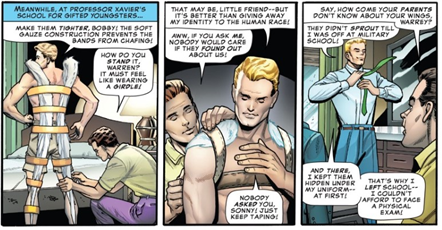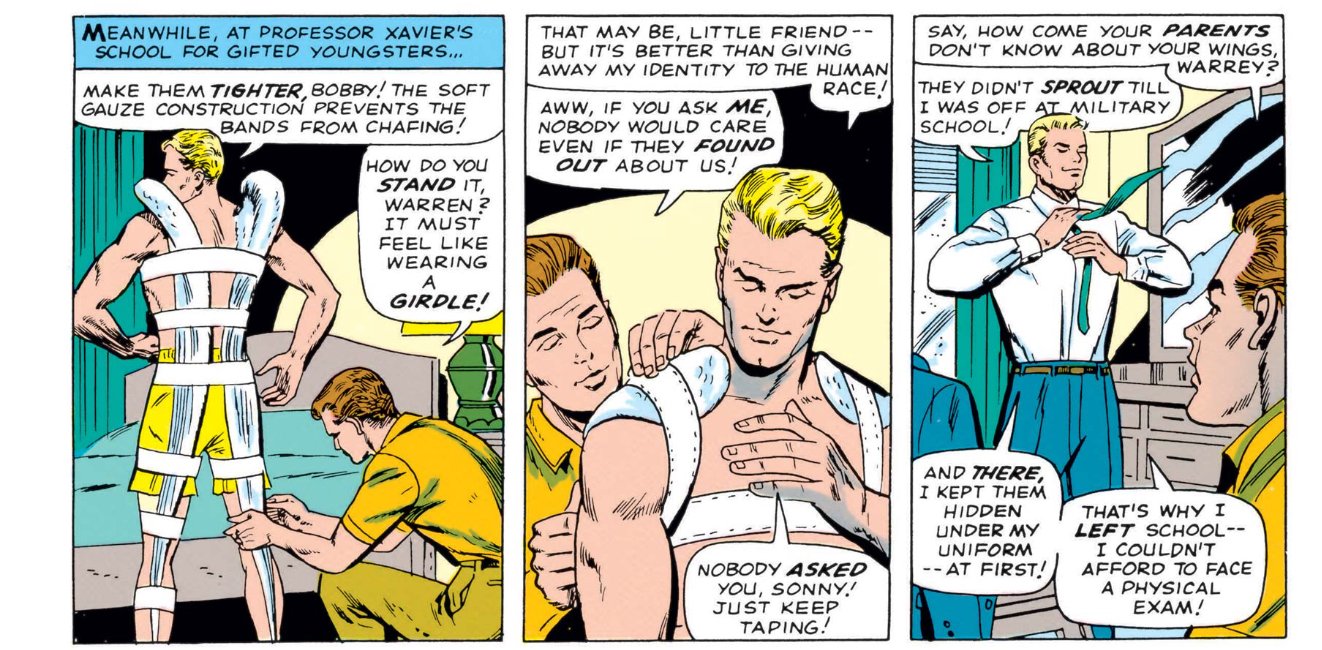
Previous Posts: Introduction | Chapter 1: Lee/Kirby Era Part 1 | Chapter 2: Lee/Kirby Era Part 2 | Chapter 3: The Roy Thomas Era (1966-1968) | Chapter 4: The End of the Silver Age (1968-1970) | Chapter 5: Origins and Flashbacks Part 1 | Chapter 6: Silver Age Flashbacks Part 2 | Chapter 7: X-Men: First Class Vol 1 | Chapter 8: X-Men: First Class Vol 2 Part 1 | Chapter 9: X-Men: First Class Vol 2 Part 2 | Chapter 10: The Hidden Years | Chapter 11: X-Men on Hiatus (1970-75) | Chapter 12: The Champions Part 1 (1975-76) | Chapter 13: The Champions Part 2 (1977-78) | Chapter 14: The College Years (1978-83) | Chapter 15: The New Defenders Part 1 (1983-84) | Chapter 16: The New Defenders Part 2 (1984-85) | Chapter 17: The End of the New Defenders (1985-86) | Chapter 18: X-Factor Part 1 (1986) | Chapter 19: X-Factor – Mutant Massacre (1987) | Chapter 20: X-Factor – Fall of the Mutants (1987)
Coming back from my hiatus to drop a note on a significant Iceman story that just dropped last month: “Early Thaw,” a short by Anthony Oliveira with art by Javier Garrón that appeared in the Marvel’s Voices: Pride anthology.
Marvel’s Voices anthologies have become a semi-regular event starting in 2020. Each issue spotlights creators from an underrepresented background, generally writing characters in the Marvel stable from that background. Pride is the LGBT special, and it’s chock full of X-Men stories.

Marvel’s Voices: Pride #1 (June 2021)
“Early Thaw”
Writer: Anthony Oliveira
Artist: Javier Garron
In a story set in the X-Men’s early days (we’ll get to when in a minute), Bobby wallows in the isolation and loneliness of the closet upon realizing that his secret crush, Angel, only has eyes for Marvel Girl, and finds a surprising voice of sympathy from Magneto, of all people. It’s a beautiful and relatable story of unrequited love and hope.
Oliveira has a clear objective with this story to make explicit the queer subtext that was always there in the original 1960s comics. He even opens with three panels that directly quote X-Men #14 — the first part of the Sentinels story. As I said when I wrote about that issue, this is barely even subtextual. It’s hard to imagine a heterosexual reading of, um, Bobby helping Warren get dressed and patting down his bare, muscular back and legs. Oliveira uses this triptych to remind the audience that, yes, Bobby has always been gay, and no, it wasn’t an invention of Brian Michael Bendis in 2015.
Above, the opening panels of “Early Thaw.” Below, the original panels from X-Men #14.
Oliveira could have gone even further back, too, but it seems significant to tie the directly to the Sentinels story, which is the first X-Men arc to really deal with mass anti-mutant hysteria, and confront the particular fact that mutants are children that are very different from their parents and are consequently alienated from their families by the closet. In short, it’s the first story that really plays up what mutants are really a metaphor for.
Bobby’s conversation with Magneto is where the story becomes really surprising and interesting. Magneto is on his way to murder Xavier with some missiles, but stops when he stumbles upon Bobby crying in the woods off the estate (that’s actually the N’Garai cairn from X-Men #96 that Bobby’s sitting on). Magneto decides to approach Bobby like a concerned authority figure to ask what’s wrong and Bobby basically confesses that he’s gay and scared. Magneto tells Bobby that even though he’s not queer, he understands why Bobby feels like an outsider because he too has been “different” all his life and he reminds Bobby that both he and the X-Men are working to make “a future less lonely for the different.” The meta note here is that Magneto is explicitly equating being a mutant with being queer, drawing out the theme of these comics for anyone still unclear.
Now, this story has a bit of a continuity conundrum. Aside from the strange wrinkle that Bobby comes out to Magneto fifty years (in publishing time) before he comes out to anyone else, it has to take place after the Sentinels story, which we actually see for a panel. But that story runs straight through to X-Men #18, which ends with Magneto taken away by the Stranger to his home planet. Magneto stays there until Avengers #47, when he finally escapes and begins a story that culminates with the Avengers/X-Men crossover in X-Men #43-45. If you squint, you could just about squeeze the story in between the pages of Avengers #47 and between X-Men #39-40. But that’s not ideal because “Early Thaw” clearly features a very young Bobby who’s still a student at Xaviers’, whereas Bobby turned 18 in X-Men #32, and by this point he’s in a “relationship” with Zelda.
Instead, I propose a pretty radical solution. Despite him having a speaking role on panel, I don’t believe Magneto is actually there in the story. I think this is a desperately lonely teenager, so afraid to come out to his friends and family, that he imagines the only person he can come out to is a man who has literally tried to kill him on several occasions. And there are certainly hints that this isn’t the real Magneto — after all, he’s not the raving lunatic Silver Age Magneto usually is, and he has at least a little of Bobby’s ironic humor. (To be fair, modern portrayals of Silver Age Magneto do tend to play down the raving looney aspects to bring him more closely in line with the modern interpretation.)
In this reading, the idyllic resolution and grandfatherly advice he gets from Magneto is really just Bobby fantasizing about how coming out to his friends might go. If that’s the case then the story fits best right between X-Men #18-19. Bobby would be about 17 years old here.
And yes, either reading would place the story after Bobby time travelled and spent a year or longer in the present and being fully out before being forced back into the closet upon the return trip.
What did you think? Is Magneto really there?


You must be logged in to post a comment.